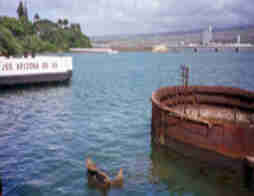 Rusted mast of sunken
USS Arizona. White pier on left marks spot where ship was berthed on Dec.
7, 1941
Rusted mast of sunken
USS Arizona. White pier on left marks spot where ship was berthed on Dec.
7, 1941
The geechee courier
 Rusted mast of sunken
USS Arizona. White pier on left marks spot where ship was berthed on Dec.
7, 1941
Rusted mast of sunken
USS Arizona. White pier on left marks spot where ship was berthed on Dec.
7, 1941

The memorial to the USS Arizona (far right and viewed from the visitors' center) straddles the ship's remains
A Memorable Visit to Pearl Harbor --50 Years Later
The Marine at the gate of the Pearl Harbor naval base was polite but firm." Do you have a military ID?," he asked. "No, we're trying to get to the USS Arizona memorial,." I said.
Obviously, he'd been through this routine before. My daughter, Leslie, her boyfriend, Chet, and I were in the wrong place. The Marine snappily gave us directions. We had missed the correct exit because we thought the sign reading "USS Arizona Memorial Stadium" was pointing to a sports arena. Must be two places.
The memorial to the men who died during the Japanese atttack on Pearl Harbor is about five minutes away from the entrance to the naval base.
The parking lots at the memorial center look like parking lots for the typical tourist attraction. Rows and rows of cars, tour buses, signs warning to lock your car -- the operators aren't responsible.
You know, however, that this is no ordinary tourist stop. The tour is free.
The visitors' center has the requisite book and gift shop and a small museum room. One display a battered shell of an aerial torpedo which hit the USS Arizona. The information card even gives the name of the Japanese pilot who fired the devastating missile. Military record keeping is amazing.
When I first looked out at the harbor, there was a moment of surprise.
What I was sub-consciously expecting was the 1941 scene so ingrained over 50 years through the dramatic pictures of the ships burning in the harbor.

But the day was serene. The sky was blue with a bank of white clouds. The water was calm. Only two military ships were berthed in the harbor instead of the 130 anchored there on Dec. 7, 1941.On one, a few Marines were on the deck, listing under the weight of huge duffel bags on their shoulders. The white memorial floating in the distance.
On the land side the high-rise skyline of Honolulu was towered over by a mountain range.
After about 30 minutes of wandering around the visitors center and grounds, it was our turn to go into the theater for a movie.
The lights went out. A deep male voice broke the silence -- along with the whines of a small boy."Welcome to the USS Arizona memorial. My name is Charles Johnson, I am one of the survivors of Pearl Harbor on volunteer duty here today..."
The mood of the day changes quickly.
The movie begins and the time machine descends. You are finally back to 1941..
There are the young U.S. sailors dancing away the Saturday night before the attack and hours before their deaths. Japanese admirals gathered around maps planning the attack. Japanese kamikaze pilots running to their planes on the way to their deaths. The eerie drone of hundreds of Japanese planes approaching their target. The body-shaking sound as the ships' ammunition dumps explode. President Franklin Delano Roosevelt's historic words as he addresses Congress: "This is a day that will live in infamy."
By the time the lights come on, the theater is quiet. Even the whining little boy has been shushed. As the group of about 100 leaves the theater for a waiting boat, there are tears in many eyes -- Americans and Japanese.
On the short boat ride, a recorded voice informs us that the memorial was dedicated in 1962 and its architect is Alfred Preis.
"Wherein the structure sags in the center but stands strong and vigorous at the ends, expresses initial defeat and ultimate victory....The overall effect is one of serenity. Overtones of sadness have been omitted to permit the individual to contemplate his own personal responses...his innermost feelings," Preis once said in explaining his intent.
The memorial is 184-feet long and crosses the midsection of the battleship barely visible under the water.
It is divided into three sections: a covered entry area; the central observation area, crisscrossed with six curved arches and seven opening on the sides and roof; and the covered shrine room where the names of the 1174 crewmen who died in the attack are engraved in black on a soaring marble wall..
The remains of many of these crewmen are locked in the ship below.
Almost un-noticed in the shrine room -- overshadowed by the names on the marble wall -- is a smaller marble "bench." On it are inscribed the names of about a dozen crewmen who survived the attack, died in later years and have been buried with their shipmates.
To maintain a proper reverence on the memorial, park rangers walk around asking the visitors to lower their voices.
For most, it is unnesesary. Looking into the water and seeing the oil still seeping to the surface and to visualize the ship as a massive tomb leaves you silent with your "innermost thoughts."
Top, looking toward the shrine aboard the memorial. Center, the flag --attached to the mainmast of the sunken ship -- flutters above the memorial. Below, oil still seeping from the ship floats toward a destroyer.
The memorial crosses the battleship
On the grounds of the visitors' center. Dude at left is unknown. Couple on right is identified as Chet and Leslie
Color photos and words by Jack Breibart. Black and white photos pilfered from unsuspecting web sites.